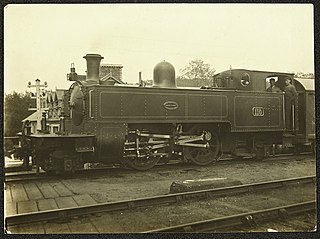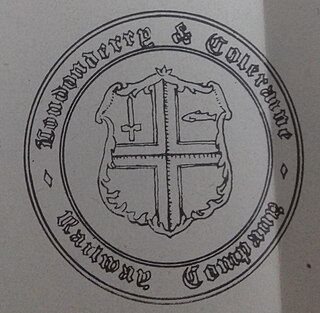
The Northern Counties Committee (NCC) was a railway that served the north-east of Ireland. It was built to Irish gauge but later acquired a number of 914 mm narrow gauge lines. It had its origins in the Belfast and Ballymena Railway which opened to traffic on 11 April 1848.

Stranocum is a small village and townland in north County Antrim, Northern Ireland. The villages of Dervock and Armoy are nearby and the town of Ballymoney is about 5 miles (8 km) away. It had a population of 297 people in the 2011 Census.

Cargan is a hamlet and townland in County Antrim, Northern Ireland. It lies at the foot of Slievenanee in Glenravel – locally known as "The Tenth Glen" along with the more widely known nine Glens of Antrim. It is part of Mid and East Antrim district. It had a population of 588 people in the 2011 Census.
Martinstown is a small village in County Antrim, Northern Ireland. Located 6 miles from Ballymena, it is situated in Glenravel, locally known as "The Tenth Glen", alongside the widely known nine Glens of Antrim.

The Belfast and Northern Counties Railway (BNCR) Class S was a class of 2-4-2T two-cylinder compound steam locomotives that was introduced for service on the 3 ft narrow gauge railways of County Antrim in north-east Ireland.
The Northern Counties Committee (NCC) Class S1 was a class of two-cylinder compound 2-4-2T steam locomotives that was introduced for service on the 3 ft (914 mm) narrow gauge railways of County Antrim in north-east Ireland. The members of the class were rebuilds of the BNCR Class S.
Ballycastle Railway was a 3 ft narrow gauge railway line which ran from Ballycastle to Ballymoney, both in County Antrim, Northern Ireland.

Capecastle or Cape Castle is a small village and townland in County Antrim, Northern Ireland, between Armoy and Ballycastle. It is part of the Causeway Coast and Glens district.

The Ballymena and Larne Railway was a 3 ft narrow gauge railway in County Antrim, Northern Ireland. The first part opened in July 1877 and regular passenger services began in August 1878, the first on the Irish 3 ft gauge railways. Passenger services ended in 1933 and the last part of the railway closed in 1950.

Berkeley Deane Wise was an Irish civil engineer who made a significant impact on the development of railways and tourism, particularly in Northern Ireland.

The Glenariff Iron Ore and Harbour Company (GIOH) was a railway and harbour company in Glenariff, County Antrim, in what is now Northern Ireland. It operated Red Bay Pier on the Antrim coast and about 4 miles (6.4 km) of narrow gauge railway between the pier and Cloughcor Mines in Glenariff. The railway was 3 ft narrow gauge and carried iron ore from the mines to the pier, where it was loaded onto cargo ships for export to ironworks in Scotland and England.

Ballygarvey railway station was on the Ballymena, Cushendall and Red Bay Railway which ran from Ballymena to Retreat in County Antrim, Northern Ireland.

Ballycloughan railway station was on the 3-ft narrow gauge Ballymena, Cushendall and Red Bay Railway which ran from Ballymena to Retreat in County Antrim, Northern Ireland.

Rathkenny railway station was on the Ballymena, Cushendall and Red Bay Railway which ran from Ballymena to Retreat in County Antrim, Northern Ireland.

Clough Road railway station was on the Ballymena, Cushendall and Red Bay Railway which ran from Ballymena to Retreat in County Antrim, Northern Ireland.

Knockanally railway station, later known as Martinstown railway station was on the Ballymena, Cushendall and Red Bay Railway which ran from Ballymena to Retreat in County Antrim, Northern Ireland.

Cross Roads railway station was on the Ballymena, Cushendall and Red Bay Railway which ran from Ballymena to Retreat in County Antrim, Northern Ireland.

Parkmore railway station was on the Ballymena, Cushendall and Red Bay Railway which ran from Ballymena to Retreat in County Antrim, Northern Ireland.

Retreat railway station was on the Ballymena, Cushendall and Red Bay Railway which ran from Ballymena to Retreat in County Antrim, Northern Ireland.

The Londonderry & Coleraine Railway is a railway line between the cities of Derry and Coleraine in County Londonderry, built by the Londonderry & Coleraine Railway Company (L&CR). The company operated the line independently for seven years before being absorbed into the Belfast & Northern Counties Railway. The line is still in use today by NI Railways and forms part of the Belfast to Derry-Londonderry rail line.











